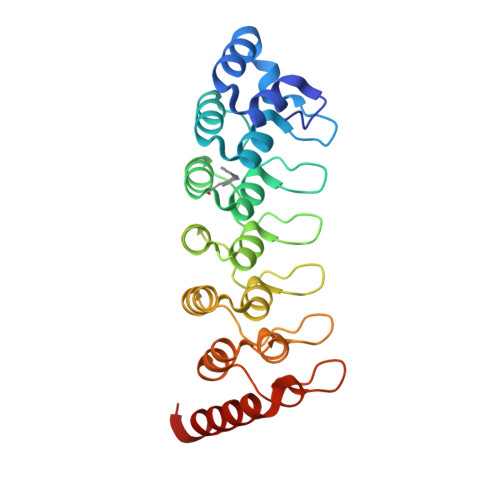Crystallographic study of a site-specifically cross-linked protein complex with a genetically incorporated photoreactive amino acid
Sato, S., Mimasu, S., Sato, A., Hino, N., Sakamoto, K., Umehara, T., Yokoyama, S.(2011) Biochemistry 50: 250-257
- PubMed: 21128684
- DOI: https://doi.org/10.1021/bi1016183
- Primary Citation of Related Structures:
3AJI - PubMed Abstract:
The benzophenone photophore is widely used to photo-cross-link macromolecules. Recent developments in genetic code expansion have allowed the biosynthesis of proteins with p-benzoyl-L-phenylalanine (pBpa) at defined sites, for covalent bonding with interacting proteins. However, the structure of a photo-cross-linked protein complex had not been revealed, and thus neither the actual structure of the "photobridge" in a complex nor the influence of this covalent bridge on the overall complex structure was known. In this study, we determine the crystal structure of the cross-linked complex of the liver oncoprotein gankyrin and the C-terminal domain of S6 proteasomal protein (S6C), at 2.05 Å resolution. First, the photoreactive amino acid was separately incorporated into gankyrin at 16 sites on the protein surface, and two variants that efficiently formed a covalent bond with S6C were found. The yield of one of the cross-linked products, with pBpa in place of Arg85 in gankyrin, was maximized for crystallization via optimization of the duration of complex exposure to 365 nm light. The structure revealed that the carbonyl group of the benzophenone of pBpa85 formed a covalent bond exclusively with the Cγ atom of Glu356 in S6C, showing the high selectivity of formation of cross-links by pBpa. In addition, the cross-linked structure exhibited little structural distortion from the native complex structure. Our results demonstrated that cross-linking with site-specifically incorporated pBpa preserves the native binding mode and is useful for probing protein-protein interactions.
Organizational Affiliation:
RIKEN Systems and Structural Biology Center, Tsurumi, Yokohama, Japan.
















